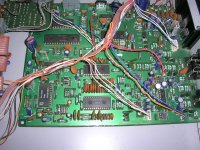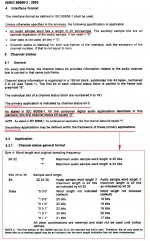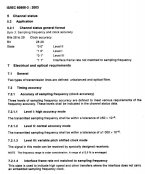Just to clarify what I meant. Once you are >100dB down mere mortals cannot hear it. Unless there is some dither on 24bit source files I'm not sure if there would be audible loss.
Obviously truncating 24 bits to 16 bits DOES cause audible issues unless you dither which was what I was mulling.
Obviously truncating 24 bits to 16 bits DOES cause audible issues unless you dither which was what I was mulling.
Please look though this paper first before debating me. Thanks.
Cool glasses, John 😎
P.S. No, they won't read it, they know better..
which article? - I have seen all official publications john has written, the infamous letter, Otala's JAES papers, Hirata's too
I much prefer Cabot/Hofer's distortion measurement summary paper and book chapter
which puts the DIM in perspective with the 3/4 century old CCIF IMD measure
I'm pretty sure I haven't misundersoood John or missed any opportunity to read anything when he has (rarely) been in the slightest revealing mood
I much prefer Cabot/Hofer's distortion measurement summary paper and book chapter
which puts the DIM in perspective with the 3/4 century old CCIF IMD measure
I'm pretty sure I haven't misundersoood John or missed any opportunity to read anything when he has (rarely) been in the slightest revealing mood
Last edited:
Me, nothing. I am very satisfied with the 16 bits (Bill, it’s only for the fun of technical discussion)
George
An honest man.
P.S. No, they won't read it, they know better..
In your dreams.
Thank you Scott but I’ve already explained that I am not the appropriate person to deal with hi-end worries.
Besides, after listening for a long through a SAE D102 (2xTDA1540P 14bit DACs) and enjoying the music much, I am left with no worries over the adequacy of 16bit depth (and 44.1kHz sampling) in conveying satisfactory and emotionally engaging sound to my ears.
To sum up my understanding with the S/PDIF 20bit limit issue:
It should not be taken for granted that an S/PDIF port is transparent to the source’s bit depth. It all depends on the digital audio transmitter chip used and it’s configuration.
Please correct me if you think I’ve got it wrong.
George
Attachments
Please correct me if you think I’ve got it wrong.
George
That seems right. I just wanted to get clarity on the notion that a stream tagged consumer can not do 24 bits which appears to not be true. I did find heated discussions, some more than 15 years old, on the subject of PC based DAW's where some manufacturers were scrambling to update their cards and firmware to support true 24 bits.
Still here? 😱
In a 247 post thread (so far) which was basically answered by post #2 and definitely before #10? 😱
This looks like a thread where John Curl would have a voice, hope it isn't so because it might degenerate into a >76000 answer thread (in the second iteration, that is) .
Oh, he wrote here?
Then may God help you 🙄
In a 247 post thread (so far) which was basically answered by post #2 and definitely before #10? 😱
This looks like a thread where John Curl would have a voice, hope it isn't so because it might degenerate into a >76000 answer thread (in the second iteration, that is) .
Oh, he wrote here?
Then may God help you 🙄
I just wanted to get clarity on the notion that a stream tagged consumer can not do 24 bits which appears to not be true
Oops!
You made me reread standard IEC 60958 –3 and now I will agree with you (thus what I wrote in post #226 is only partially correct)
As I understand, by the “a stream tagged consumer” you mean a stream which has “0” at the bit 0 of Byte 0 of the Channel status.
Well, although this means consumer as a ‘primary’ application (which would render it to 20bit max), there is the ‘secondary’ applications option, which for the case of audio word length is materialized by bit 32 of the Channel status
If bit 32 on Byte 4 is
“0”, then maximum audio sample word length is 20 bits
“1”, then maximum audio sample word length is 24 bits
Restrictions: There is Byte 1 (bits 8 to 15 included) which sets the category code. Each category has a fixed audio word length (all are less than 20bits, see para 5 and annexes).
Conclusion: A digital audio stream tagged consumer can do 24 bits.
P.S. What I also found in the standard is that bits 28, 29 of Byte 3 define the clock accuracy (transmitted sampling frequency tolerance).
End of OT journey 🙂
George
Attachments
Nelson Pass and the slew rate
2002
High-speed 100W amplifier design
100 W at 8 Ohms -> 28,28 Vp x 0.7V/us = 19.8 V/us with 100 kHz (39.6 V/us with 200 kHz)
2002
High-speed 100W amplifier design
Then 100 kHz -> 0.7V/us per peak output voltThis design, by Giovanni Stochino, appeared in the April 1997 issue of Electronics & Wireless World, with a final article in August 1998, in which he presented a slightly modified "practical" circuit. These constituted the last of a series of articles in EWW concerned with slew rate, including three technical discussions by Stochino and one by Ben Duncan (April 1995), the latter arguing that most conventional amplifiers didn't cope well either with modern recorded material or with high frequency spurious signals (though some might argue that a lot of modern music falls in the latter category...). Duncan quotes a criterion of Nelson Pass' supporting a minimum slew-free full-power bandwidth of 200kHz (corresponding to a slew rate of 1.4V/us per peak output volt), and praises the subjective treble quality of amplifiers (including his own Rauch DVT!) which are optimised for high slew rate...
100 W at 8 Ohms -> 28,28 Vp x 0.7V/us = 19.8 V/us with 100 kHz (39.6 V/us with 200 kHz)
Last edited:
Nelson Pass and the slew rate II
2008
Nelson Pass: Simple Sounds Better Page 3 | Stereophile.com (at the end of page)
Nelson Pass: Simple Sounds Better Page 4 | Stereophile.com
2008
Nelson Pass: Simple Sounds Better Page 3 | Stereophile.com (at the end of page)
Nelson Pass: Simple Sounds Better Page 4 | Stereophile.com
On record ticks and pops I could register slew rates as high as 20–30V/µs—real signals that were being processed through the differentiating network and then onto a storage 'scope. So it came time to play some music. Again, if you clipped the amplifier you could see 40 and 50V/µs recovery; that is to say, the amplifier, in catching up from clipping to get to where the signal was, would travel that fast to catch up. So clearly the system—the amplifier and the measuring system—were capable of resolving 40 and 50V/µs transients. In playing music we were looking at piano, cymbals, violins—a large range of instruments all played loud, near the power capacity of the amplifier. And we were getting values like 0.1V/µs, 0.5V/µs. In fact, at that time in that series of tests, the highest transient we were able to achieve was about 1V/µs. So the 10:1 ratio would dictate that you would need at least 10V/µs performance. That was somewhat faster than some of the slow amps that were being criticized at that time, which were in the 4 and 5V/µs range. But clearly, I didn't see where slew was overloading them as such...
Last edited:
No wonder this thread is so confusing! Back when I was learning about this stuff, a byte only had eight bits, and we numbered them 0 to 7.Oops!
You made me reread standard IEC 60958 –3 and now I will agree with you (thus what I wrote in post #226 is only partially correct)
As I understand, by the “a stream tagged consumer” you mean a stream which has “0” at the bit 0 of Byte 0 of the Channel status.
Well, although this means consumer as a ‘primary’ application (which would render it to 20bit max), there is the ‘secondary’ applications option, which for the case of audio word length is materialized by bit 32 of the Channel status
If bit 32 on Byte 4 is
And we were grateful for them. I took my eight bits with me to school and back home everyday, uphill both ways.
And we were grateful for them. I took my eight bits with me to school and back home everyday, uphill both ways.
https://www.youtube.com/watch?v=Xe1a1wHxTyo
The Stochino amp is 300V/us. I know because its currently on my bench.
In case it has not been mentioned....you want to reproduce the source sound field. How a musical instrument produces a particular sound depends on numerous variables but due to plain physics, the attack or transient rate of string and horn or flute type instruments is rather low, what matters more is the attack / rise rate of its respective harmonics so one needs to reproduce the fastest rising harmonic. No harmonics has been measured to rise faster than 15 µsec. I do not have data for percussion instruments or drums. Assuming the very unlikely case that the fastest harmonic is also the harmonic with the highest amplitude, then the amp slew rate should be a minimum of 30 volts/ 15µsec.
It can be made faster but the limiting device is the speaker. Very few show such a rise time.
It can be made faster but the limiting device is the speaker. Very few show such a rise time.
HF phase shift and that to avoid it requires bandwidth at least x 10 in excess 200kHz
6moons King 60V Maraschino (class D amplifier)
-> 6moons audioreviews: Digital Amplifier Company King 60V Maraschino [page 4]
6moons King 60V Maraschino (class D amplifier)
-> 6moons audioreviews: Digital Amplifier Company King 60V Maraschino [page 4]
Now we swapped the nCores for the Maraschinos and started the with/without procedure all over again. Playing the same 24/176.4 tracks at the same SPL, there was a bigger difference. It did appear that the Maraschinos offered the super tweeters more material to process. The resultant sound was more fluid and resolved. More analog perhaps? For some reason, the >50kHz frequency response of the Hypex nCore 1200 amps was challenged by the >85kHz reach of the Maraschinos. Either is relatively low compared to the animal kingdom where dogs hear up to 60kHz, mice to about 70kHz and bats beat them all at 200kHz. Just so, there apparently was extra signal sent to the super tweeters by the American mini amps.
With the yes/no phase behind us, we could get on with undisturbed listening. We played a wide variety of music and tried to put our fingers on the pulse behind the phenomenon of the more analog open presentation. After many discs and still more discs, we concluded that on purist recordings with a minimum of studio processing, extended frequency response offers more of what the Germans call Stoßwelle or shockwave. That is the impulse which leads any sound, its first attack. In live music, that attack makes the music come alive. Its absence betrays the fact that we deal with a recording. In many recordings however, that undulled attack is still part of the signal and not eroded by manipulation. It is then only a matter of retrieving said impulse. To us it appeared that wider frequency response—and perhaps 85kHz is just the beginning—enables superior retrieval of the attack information. [Goldmund for example talk of HF phase shift and that to avoid it requires bandwidth at least x 10 in excess of human bandwidth, i.e. 200kHz at minimum but many of their amps reach into the MHz band, a feat well beyond current class D. That argument isn't about hearing more information per se but more accurate reproduction of what occurs inside the ears' limited bandwidth - Ed.]
Last edited:
- Status
- Not open for further replies.
- Home
- Amplifiers
- Solid State
- What is the steepest realistic audio transient in terms of V/us?


